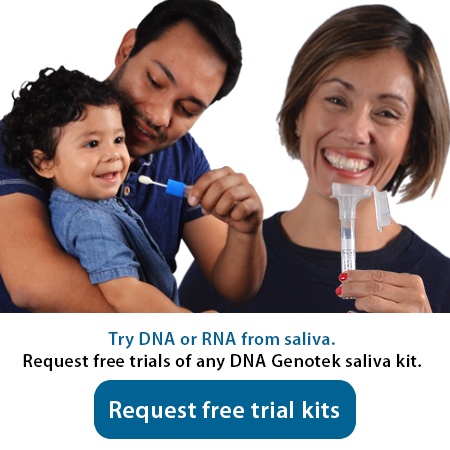2021-09-16
Not getting the participation numbers you were hoping for your study? Donor recruitment is the most challenging part of any study. The larger the study, the harder it is to find donors, right? What if I told you, it does not need to be that difficult, that there are ways to overcome the challenges of DNA sample collection?
Here are 4 ways to improve donor participation and recruitment for DNA sample collections.
#1: Pick a non-invasive collection method to improve donor compliance
Donor recruitment is one of the most challenging aspects of a research project. By selecting a sample type that eliminates the barriers of DNA sample collection, naturally, will foster a high participation rate, improve access to donors and keep collection costs to a minimum.
The most popular sample types currently used for DNA collection are:
- blood,
- saliva,
- and buccal swabs.
Off the bat, most know that blood is the most invasive option. For years blood has often been viewed as the standard for collecting high-quality DNA, however, several studies have pointed out that invasive venipuncture is the main reason for recruitment refusal. Not only is it painful, but it also introduces challenges for cohorts involving children or donors who fear needles.
Additionally, blood collection requires access to clinical infrastructure. It cannot be self-collected and requires a phlebotomist to collect the blood sample from the donor. If you are trying to keep costs at a minimum, this sample type usually requires researchers to provide high incentives to their donors to get their desired number of participants.
Many researchers turn to buccal swabs to avoid the challenges of blood collection, however buccal swabs are not without their share of challenges too... Buccal swabs require donors to scrape the sides of their cheeks in their mouths using either a dry-flocked swab or a cytobrush, sometimes causing bleeding due to the abrasive swab. This method has proven to be challenging with donors such as young children or donors suffering from psychological disorders. 1
Saliva collection has come to be known for the superior advantages it has over blood and buccal swabs. Saliva sample collection requires donors to spit into a tube (such as products like DNA Genotek’s Oragene) or soak up the saliva in their cheek pouches using sponge swabs (in devices like DNA Genotek’s ORAcollect) without the need to scrape the cheeks. Researchers save time and effort on recruiting donors for saliva collection and are more likely to spend less on donor incentives. Saliva collection for DNA improves patient care and donor compliance by providing a simple, painless alternative that removes the inconvenience, anxiety, and cost of going to a clinic for a blood draw.
FUN FACT: Blood collection has an average of 30% compliance rate compared to a 70-95% compliance rate for non-invasive saliva collection. 2
Related Content: Rinse, Swab, or Spit – What's the real source of DNA in saliva?
#2: Ensure sample collection instructions are easy to comprehend
If you do opt for a non-invasive collection method, like saliva, that does not require trained health personnel to collect the sample you should make sure that the method you use has easy-to-follow instructions for donors to follow. Failure to comprehend and collect the DNA sample will lead to laboratory failures.
As a researcher who is likely used to sample collections, you are probably thinking that collecting a saliva sample is straightforward. However, to the naïve donor, it may be their first time collecting a DNA sample and they would require easy-to-follow instructions, so your samples are collected correctly each time.
The devices found in DNA Genotek’s saliva collection product lines Oragene and ORAcollect have all been validated with easy collection instructions to ensure donors collect their DNA samples properly. Based on data obtained from a saliva collection usability study involving 122 naïve adult donors, who received a direct-to-consumer saliva collection kit:
- 95.6% of donors agreed or strongly agreed that the instructions were easy to understand
- 96% of donors understood how to collect their saliva samples properly, and
- 99.5% of donors understood how to send the samples back to the laboratory. 3
Related Content: While social distancing, reaching donors shouldn’t be an issue
#3 Make sample collection easy for participants
Not all donors are able to travel to the clinical or hospital to provide samples, but that does not mean they should be excluded as study participants. If you want to reach as many donors as possible, introducing an at-home collection arm to your study can extend your reach and increase your participation numbers.
There are several at-home self-collection kits available. When considering which kit to use, finding one that ensures sample stability is important. Degraded samples will lead to laboratory failures and result in the need to recollect from donors.
The best way to protect your sample is to use a self-collection kit containing a DNA stabilization solution that allows the DNA sample to be stored at room temperature. Keeping an unstabilized DNA sample frozen during transit back to the lab can be quite difficult for your donors, and temperature fluctuations can negatively impact the stability of the sample and therefore affect the donor’s sample results when it reaches the lab. One researcher requested that their donors immediately put their samples into a box with dry ice for cold chain transportation back to the lab. This can be incredibly costly and risky; you can learn more about why these methods are risky and costly in our blog here: The power of ambient temperature sample shipping and storage.
At DNA Genotek, many of our collection kits are at-home, self-collection kits designed to be shipped via regular postal services. Oragene and ORAcollect saliva collection kits contain a stabilization solution that stabilizes nucleic acids at ambient temperature, preventing sample degradation with fluctuating temperatures during shipping.
Related Content: 3 reasons why you should stabilize your DNA sample correctly
#4 Have different methods available for all types of donors
Not every donor will be an adult who can easily spit into a tube. Most cohorts are diverse or focus on specific donors like children, and those who have difficulty spitting, so you can’t go with a “one size fits all” solution. To overcome this challenge, having access to multiple sample collection methods is crucial to ensure that you can collect DNA from your donor population.
For example, DNA Genotek’s Oragene and ORAcollect saliva collection product lines are made with multiple form factors to cater to every type of donor. The Oragene product line has direct spit and assisted collection kits, ensuring all donor types can be collected from, and the ORAcollect kit’s unique design makes it ideal for self or assisted collection from donors of all ages. Learn more about collecting saliva from difficult to collect donors, here: How to obtain enough DNA from saliva with difficult to collect donors
Selecting the right tool for the job means more access to donors and if you follow these 4 tips, we can guarantee that your participation numbers will improve as well as your donor compliance – making the most challenging part of the study...no longer challenging!
If you would like to learn more about Oragene and ORAcollect, you send us an email at info@dnagenotek.com or send us a request to try some free sample kits for your lab by clicking the image below.
References:
[2] https://www.dnagenotek.com/US/saliva-is-easier.html
[3] https://www.dnagenotek.com/US/pdf/MK-BR-00035.pdf


